By Manzanillo Sun Writer from the June 2015 Edition
More Than Just a Vegetable
It is often a challenge to identify or to try unknown vegetables and fruits when shopping and touring the local markets in Manzanillo (or elsewhere in Mexico). Since you don’t know what they are one might just ignore them until one day a dish is served by a friend or in a restaurant and you make the discovery. Over the years we have learned to love the freshness and taste of the produce that is grown in the countryside all around our beautiful coastal winter home. For me, there is simply no comparison to the taste of fruits and vegetables ripened on the vines and trees and brought directly to market.
Thanks to world-wide shipping and sophisticated transportation systems in our global economy, Canadians like me, are certainly grateful for the exotic tastes of fresh fruits and veggies that are now available all year round. We have a short growing season in Canada and thus must rely on these imports through winter and spring. But I must confess that absolutely nothing tastes as good as the locally grown products simply because those bound for export must be picked, packed and shipped prior to ripening in order to survive the journey.
I have so many old memories of my mother canning fruits and vegetables to see us through the winter months. Eventually, she turned to freezing many items when the new chest- type freezers became an everyday household appliance. But nothing compared with the fresh produce that came out of our own backyard garden. It is these fresh wholesome flavors that are found in the local Mexican markets.
My first sampling of Jicama (pronounced hick-a-mah) was at a social event where plates of what looked to be raw potato fries were served. They were sprinkled with a bit of lime juice and chili powder and were crunchy and delicious. Jicama is also known as yam bean and is a round fleshy taproot vegetable of the bean family. Other names are Mexican water chestnut or Mexican turnip. Its underground starchy root is one of the popular edible tuber-vegetables grown in many parts of Mexico, Central America, South Asia, and the Caribbean. They can be found in most local markets and grocery stores throughout Mexico and are extremely popular. I have yet to see them in Canada.
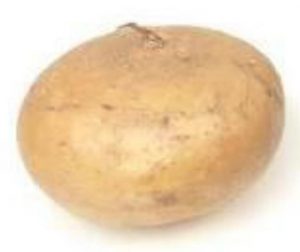
HEALTH BENEFITS OF JICAMA
As a root vegetable Jicama is very low in calories with only 35 calories per 100g. Yet its high quality phyto-nutrition profile comprises high dietary fiber, anti-oxidants and small amounts of minerals and vitamins
It is one of the finest sources of soluble inulin dietary fiber. The root pulp provides 13% of fiber! Or, 2/3 of one cup equals 4.25 g of fiber. Inulin is a zero calorie sweet inert carbohydrate. Since it does not metabolize inside the human body, it’s an ideal snack for diabetics and dieters.
Jicama is rich in vitamin C. Vitamin-C is a powerful water-soluble anti-oxidant that helps rid the body of harmful free radicals, thereby offering protection from cancers, inflammation and viral cough and cold.
Additionally, Jicama also contains small levels of vitamin B-complex and some important minerals like magnesium, copper, iron and manganese.
In Mexico Jicama is available all year round. My research tells me that they could show up in the U.S.A. in the spring and summer as an import from South America. You should select firm, round and well-formed medium sized tubers. Avoid those that are bruised, cut, soft or shriveled. Once you have them home they can be stored like potatoes for up to a month. Once cut, any remainders should be refrigerated.
Wash Jicama in cool running water and pat dry. It is important to peel off the thick fibrous skin with a knife or vegetable peeler. There is an organic poison in the skins that contain rotenone so be sure to discard them. Otherwise Jicama is perfectly safe.
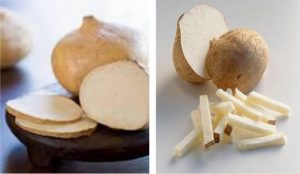
SERVING TIPS:
Jicama has a sweet succulent apple like fruity taste. Slice into raw cubes or sticks and sprinkle with lime juice or salt or, dress with olive oil and paprika or ground chili pepper.
As a favored root vegetable, Jicama is used in salads, stir fries, stews, soups and so on. It mates well with other common vegetables and fruits like oranges, pineapple, carrot and green beans. Serve with poultry, meat and seafood.
RECIPE SAMPLE:
SPICY JICAMA FRIES
INGREDIENTS
For the Jicama Fries:
1 medium jicama
1 tablespoon oil of your choice (coconut or canola oil both work great)
½ teaspoon cumin
½ teaspoon turmeric
½ teaspoon garlic powder
¼ teaspoon smoked paprika
¼ teaspoon salt
¼ teaspoon black pepper
¼ teaspoon onion powder
Pinch cayenne or chili powder (or more, to taste)
For the Cilantro-Garlic-Lime Greek Yogurt Dip:
½ cup plain Greek yogurt
¼ cup cilantro, chopped
1 clove garlic, minced
Juice of ½ lime
DIRECTIONS
1. Preheat oven to 400 degrees F. Line a baking sheet with parchment paper and set aside.
2. Peel the jicama and cut into skinny fries. You don’t want to make them thick, they don’t bake as well when they’re wider.
3. Place the jicama in a microwave-safe bowl with a tablespoon of water. Cover and microwave for 6 minutes. This will prevent the jicama from staying too crisp and raw inside when the outside bakes.
4. As you wait for the jicama to precook in the microwave, mix together the yogurt dip ingredients and set aside.
5. If there is any water left in the bowl holding the jicama, pour it out. Drizzle the jicama with the tablespoon of oil and add the spices. Toss until evenly coated. Beware! Turmeric will stain your hands temporarily so you might want to use a utensil!
6. Spread the jicama fries out on the prepared baking sheet and bake for about 35-45 minutes, or until they begin to brown in spots, tossing once.
7. Serve warm with the dip.
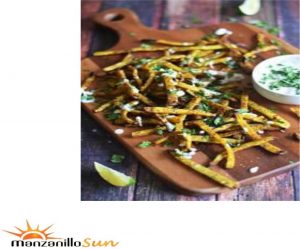
Download the full edition or view it online
Manzanillo Sun’s eMagazine written by local authors about living in Manzanillo and Mexico, since 2009
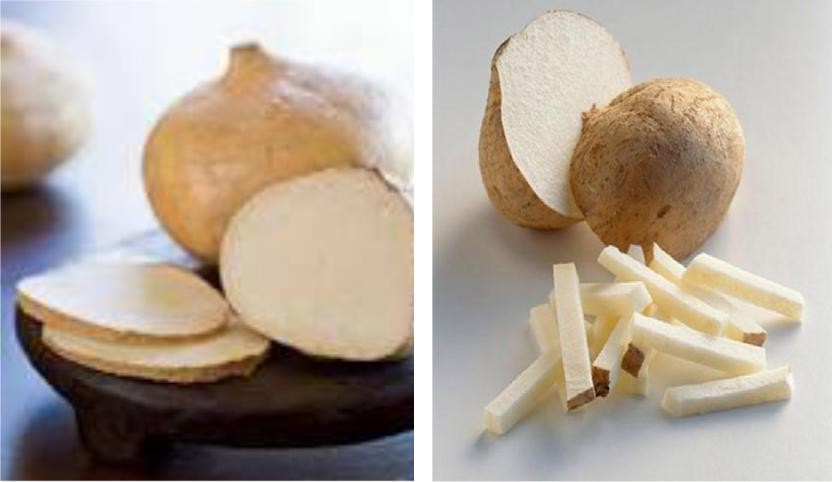


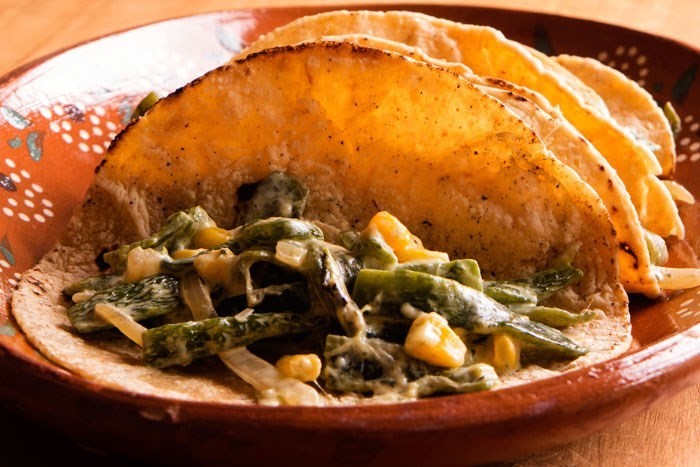

You must be logged in to post a comment.